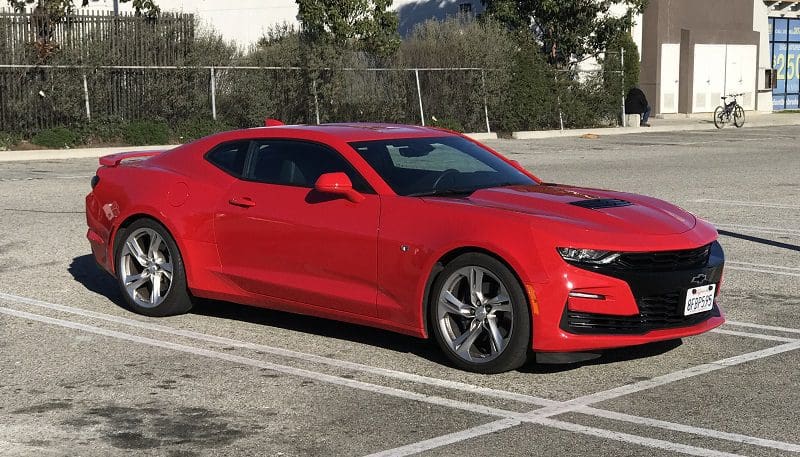
With the increasing performance and features of factory-installed infotainment and audio systems, many of my friends have asked whether we still need aftermarket audio systems. I was recently in California on business and rented a 2018 Chevrolet Camaro SS for my drive from Long Beach to Modesto and back to San Francisco. Having spent about 12 hours in the car over the week, I can tell you beyond a shadow of a doubt that the people who are making decisions about original equipment audio systems still have a long way to go before they can match the capabilities of a properly designed and tuned aftermarket audio system. If you’re wondering what I’m talking about, keep reading.
I’m Not a Muscle Car Guy
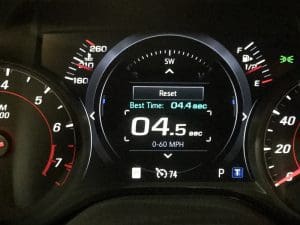 My decision to rent the Camaro was based on the fact that I knew I’d never want to own one of these vehicles. With a functionally microscopic trunk opening, the car is useless in terms of hauling my kids’ hockey equipment around. The rear-wheel-drive platform, even when equipped with snow tires, will never match the performance of an all-wheel-drive vehicle in the snow, and the massive blind spots in the rear quarters are the nail in the coffin for me. I will say, though, that as a car enthusiast, I get the appeal. Sure, I tromped on the loud pedal several times and I have it on good authority that this beast will easily run from zero to 60 in about 4.5 seconds. It’s awesome and hilarious at the same time. The car also handles quite well, as long as the road is smooth, so accelerating onto the freeway can be a blast. Lastly, it was very comfortable when cruising up Interstate 5 and I managed to average an impressive gas usage of 28 miles per gallon on my week-long trip. That’s simply amazing mileage for a 6.2L V-8 that can produce 455 horsepower.
My decision to rent the Camaro was based on the fact that I knew I’d never want to own one of these vehicles. With a functionally microscopic trunk opening, the car is useless in terms of hauling my kids’ hockey equipment around. The rear-wheel-drive platform, even when equipped with snow tires, will never match the performance of an all-wheel-drive vehicle in the snow, and the massive blind spots in the rear quarters are the nail in the coffin for me. I will say, though, that as a car enthusiast, I get the appeal. Sure, I tromped on the loud pedal several times and I have it on good authority that this beast will easily run from zero to 60 in about 4.5 seconds. It’s awesome and hilarious at the same time. The car also handles quite well, as long as the road is smooth, so accelerating onto the freeway can be a blast. Lastly, it was very comfortable when cruising up Interstate 5 and I managed to average an impressive gas usage of 28 miles per gallon on my week-long trip. That’s simply amazing mileage for a 6.2L V-8 that can produce 455 horsepower.
2018 Chevrolet Camaro Bose Audio System
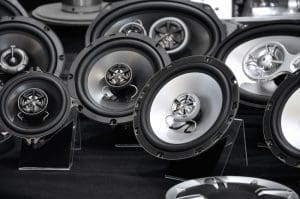 Once I was out of Long Beach and Los Angeles, and had the cruise control set, it was time to play with the stereo in the car. The door speakers were branded with the well-known Bose badge and according to the Bose and Chevrolet websites, there were a total of 9 speakers in the car … somewhere? I saw grilles in the outer corners of the dash, and I assumed there were more speakers in the rear seat area. Nevertheless, the quantity of speakers never impresses me; I’m all about how the system sounds.
Once I was out of Long Beach and Los Angeles, and had the cruise control set, it was time to play with the stereo in the car. The door speakers were branded with the well-known Bose badge and according to the Bose and Chevrolet websites, there were a total of 9 speakers in the car … somewhere? I saw grilles in the outer corners of the dash, and I assumed there were more speakers in the rear seat area. Nevertheless, the quantity of speakers never impresses me; I’m all about how the system sounds.
I connected my iPhone to the USB port in the center console, but because I have a 7S Plus, I had to leave the phone on the seat because the cover wouldn’t close over my monstrous “hand computer” (as my kids call it). I don’t have a lot of music on my phone, but there are enough tracks that I can quickly quantify the performance of any audio system I want. By 11 seconds into Paul Simon’s “The Boy in the Bubble,” I was looking for the audio adjustment menu. The bass produced by the factory sound system was overwhelming and completely unnatural.
 After turning the bass control down four or five notches, things were better. The emphasis in the midbass region was gone and things started to sound more realistic. Had there been any fun bass below 40 Hz, it was now gone, but at least the drums sounded like drums.
After turning the bass control down four or five notches, things were better. The emphasis in the midbass region was gone and things started to sound more realistic. Had there been any fun bass below 40 Hz, it was now gone, but at least the drums sounded like drums.
At about 30 seconds into the track, Paul started singing. Much to my dismay, his voice was coming from a location just to the left of the instrument cluster. Has nobody at General Motors ever been to a concert? The lead singer is usually in the middle of the stage, not standing by the left speaker bank! I played with the balance control in hopes of centering Paul’s voice, but adjusting things to the right only blurred the image and spread his voice across the dash.
Yes, folks, that’s the end. I was done: 60 seconds and I didn’t want to listen to this system anymore. I started playing with the strange lighting options around the dash display and the doors, and spent the rest of the trip switching from one radio station to another.
The Aftermarket Can Do Much Better
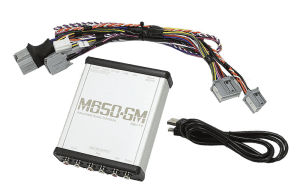 Let’s say that I owned this car. How would I fix the stereo? Well, since the radio is part of the dash and includes the climate controls and vehicle configuration options, I’d contact someone like NAV-TV and order one of their M650-GM MOST audio interfaces. This interface extracts a full-bandwidth, unprocessed audio signal from the digital connection between the “radio” and the amplifier in the trunk so I can feed it to aftermarket equipment.
Let’s say that I owned this car. How would I fix the stereo? Well, since the radio is part of the dash and includes the climate controls and vehicle configuration options, I’d contact someone like NAV-TV and order one of their M650-GM MOST audio interfaces. This interface extracts a full-bandwidth, unprocessed audio signal from the digital connection between the “radio” and the amplifier in the trunk so I can feed it to aftermarket equipment.
Depending on my mood and goals for the system, I’d probably choose a four-channel and a large five-channel amp for the upgrade. One amp would run a set of upgraded midrange speakers in the dash locations and a set of tweeters molded into the A-pillars to be on-axis with the listening position. I’d add a set of high-quality midbass drivers to the door speaker location, using the four channels of the five-channel amp in a bridged configuration so I had lots of power. Finally, I’d construct a vented enclosure for a single high-quality 10-inch sub in the trunk and power it from the subwoofer channel of the five-channel amp.
The Importance of Digital Signal Processing
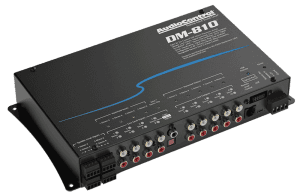 While the speaker upgrade will reduce distortion in the system and improve its clarity, the real upgrade would come from a digital signal processor (DSP). I’d pick something with a TOSLINK digital input that would connect to the M650-GM and provide at least eight outputs (tweeters, mids, midbass and subwoofer). Having full control over the signal going to each speaker in the vehicle means that I can set the signal delay and output level controls so the output of each speaker arrives at the listening position simultaneously, and is perfectly balanced from left to right. Lastly, I’d work through my standard tuning process to ensure the left and right channels match perfectly and the system would create an accurate image that was tightly focused in the center of the windshield under the rear-view mirror. (Remember what I said about the lead singer standing in the middle of the stage?)
While the speaker upgrade will reduce distortion in the system and improve its clarity, the real upgrade would come from a digital signal processor (DSP). I’d pick something with a TOSLINK digital input that would connect to the M650-GM and provide at least eight outputs (tweeters, mids, midbass and subwoofer). Having full control over the signal going to each speaker in the vehicle means that I can set the signal delay and output level controls so the output of each speaker arrives at the listening position simultaneously, and is perfectly balanced from left to right. Lastly, I’d work through my standard tuning process to ensure the left and right channels match perfectly and the system would create an accurate image that was tightly focused in the center of the windshield under the rear-view mirror. (Remember what I said about the lead singer standing in the middle of the stage?)
 I’ve built this exact system in friends’ vehicles and a similar system in my 2013 Subaru WRX STI, and I can tell you exactly what it sounds like. First and foremost, you can’t tell where the speakers are. The music comes from a focused virtual soundstage that spans the entire width of the windshield — just as though you were at a live concert or sitting at the console of a world-class recording studio. Assuming the recording is well-executed, each performer would be easily identifiable in their relative lateral positions across the soundstage. If the recording is amazing, there would also be a real sense of depth to the listening experience. Bass would rock solid with excellent impact, dynamics and low-frequency extension. I love having bass that extends way below 20 Hz, so I tune the vented enclosures I design quite low or use sealed enclosures.
I’ve built this exact system in friends’ vehicles and a similar system in my 2013 Subaru WRX STI, and I can tell you exactly what it sounds like. First and foremost, you can’t tell where the speakers are. The music comes from a focused virtual soundstage that spans the entire width of the windshield — just as though you were at a live concert or sitting at the console of a world-class recording studio. Assuming the recording is well-executed, each performer would be easily identifiable in their relative lateral positions across the soundstage. If the recording is amazing, there would also be a real sense of depth to the listening experience. Bass would rock solid with excellent impact, dynamics and low-frequency extension. I love having bass that extends way below 20 Hz, so I tune the vented enclosures I design quite low or use sealed enclosures.
Tonally, everything sounds real and natural. The balance between the midbass, midrange and high-frequency content is smooth and realistic. There’s a little extra output from the sub below 50 Hz to make listening fun and to drown out some road and exhaust noise.
The best part is that when the volume gets turned up, the system just plays louder and louder, but the overall balance and clarity don’t change significantly. This clarity and linearity is credited to high-quality speakers that include distortion-reducing features like aluminum shorting rings, properly damped cone and dust cap designs, large diameter voice coils, and impressive excursion capabilities.
OEM Audio System Engineers are Smart
 I want to make it extremely clear that the people who work at companies like Bose and Harman know what they are doing. I have good friends who tune OEM audio systems for a living, and their personal vehicles have some of the best-sounding mobile audio systems on the planet. With that said, companies like Chevrolet are their clients, and the audio suppliers deliver what they are asked to deliver — right or wrong — so don’t blame Bose for this horrible audio system; blame General Motors.
I want to make it extremely clear that the people who work at companies like Bose and Harman know what they are doing. I have good friends who tune OEM audio systems for a living, and their personal vehicles have some of the best-sounding mobile audio systems on the planet. With that said, companies like Chevrolet are their clients, and the audio suppliers deliver what they are asked to deliver — right or wrong — so don’t blame Bose for this horrible audio system; blame General Motors.
Better yet, don’t pay any attention to the audio system at all. If your car stereo doesn’t put a smile on your face when you play your favorite music, then visit your local specialist mobile electronics retailer and see what they can do to improve it. It may require something simple like the addition of a subwoofer, or you may need to gut the entire stereo to achieve truly stellar performance. Trust me when I say that having an amazing audio system in your car can transform even the most-mundane commute or monotonous drive into a truly enjoyable musical experience.
